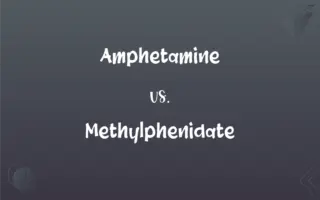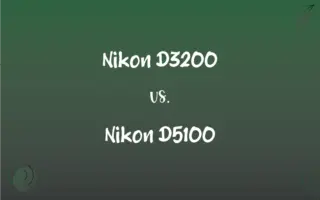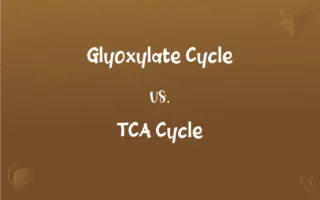Endonuclease vs. Exonuclease: What's the Difference?
Edited by Aimie Carlson || By Harlon Moss || Updated on October 29, 2023
Endonucleases cut DNA within the molecule, while exonucleases remove nucleotides from the ends.

Key Differences
Endonucleases and exonucleases are two types of enzymes that play pivotal roles in DNA manipulation and processing. An endonuclease acts by recognizing and cleaving specific sequences within a DNA molecule, making internal cuts. In contrast, an exonuclease works by trimming nucleotides, one by one, from the ends, either the 5' or 3' end, of a DNA or RNA molecule.
The function of endonucleases is critical in many biological processes, including DNA repair and recombination. These enzymes ensure the integrity and stability of the genetic material. Exonucleases, on the other hand, have functions that range from DNA repair to the degradation of unwanted or misprocessed nucleic acids. They can be thought of as molecular scissors, trimming away the edges of the DNA or RNA strand.
Endonucleases are often harnessed in molecular biology for their precision. The recognition of specific DNA sequences allows researchers to target and cut at exact locations within the genome. This is particularly beneficial in techniques like genetic engineering or cloning. Exonucleases, with their ability to methodically remove nucleotides from the end of a strand, are valuable in processes that require the generation of single-stranded DNA, as in certain DNA amplification techniques.
While both endonucleases and exonucleases have distinct modes of action, they can sometimes work in tandem in certain cellular processes. For instance, during DNA repair, an endonuclease might make an initial cut, and then exonucleases trim the damaged section, allowing the gap to be filled in correctly. Despite their functional differences, both enzyme types are essential for maintaining the accuracy and health of an organism's genetic information.
Comparison Chart
Site of Action
Internally within DNA or RNA
Ends of DNA or RNA
ADVERTISEMENT
Function
Cuts at specific sequences
Removes nucleotides one by one
Use in Laboratory
Genetic engineering, cloning
DNA amplification, generating single-stranded DNA
Biological Process
DNA repair, recombination
DNA repair, nucleic acid degradation
Mode of Action
Recognizes and cleaves specific sequences
Trims nucleotides from 5' or 3' end
Endonuclease and Exonuclease Definitions
Endonuclease
Endonucleases are enzymes that cleave DNA internally.
Scientists use endonucleases to target and cut specific DNA sequences.
ADVERTISEMENT
Exonuclease
Exonucleases can act on either 5' or 3' ends of nucleic acids.
The exonuclease began removing nucleotides from the 3' end of the DNA.
Endonuclease
Endonucleases function in DNA repair and recombination.
An endonuclease can cut damaged DNA, initiating the repair process.
Exonuclease
Exonucleases generate single-stranded DNA in certain techniques.
To create single-stranded templates, the lab technician employed exonuclease activity.
Endonuclease
Endonucleases are molecular scissors for DNA.
Using an endonuclease, researchers can introduce breaks at desired locations in the DNA.
Exonuclease
Exonucleases trim nucleotides from DNA or RNA ends.
The exonuclease activity was evident as the DNA strand was shortened from its end.
Endonuclease
Endonucleases cut DNA at specific sites within the molecule.
The ability of endonucleases to make internal cuts is exploited in many biotechnological techniques.
Exonuclease
Exonucleases methodically remove nucleotides one by one.
With exonuclease treatment, the DNA strand was gradually trimmed.
Endonuclease
Endonucleases recognize and act on specific DNA sequences.
The precision of endonucleases is vital for genetic engineering applications.
Exonuclease
Exonucleases are essential for DNA repair and degradation.
The cell utilizes exonucleases to remove mismatched nucleotides during DNA repair.
Endonuclease
Any of a group of enzymes that catalyze the hydrolysis of bonds between nucleotides in the interior of a DNA or RNA molecule.
Exonuclease
Any of a group of enzymes that catalyze the hydrolysis of single nucleotides from the end of a DNA or RNA chain.
Endonuclease
(enzyme) Any enzyme which catalyzes the cleavage of nucleic acids so as to produce variously sized fragments.
Exonuclease
Any of a group of enzymes which cleave single nucleotides from the end of a polynucleotide (DNA or RNA) chain.
Endonuclease
A nuclease that cleaves nucleic acids at interior bonds and so produces fragments of various sizes
Exonuclease
A nuclease that releases one nucleotide at a time (serially) beginning at one of a nucleic acid
FAQs
What do endonucleases do?
Endonucleases cut DNA or RNA at specific internal sequences.
Why might a cell use exonucleases?
Cells use exonucleases for purposes like DNA repair, degrading unwanted nucleic acids, and processing RNA.
Can endonucleases and exonucleases work together in a process?
Yes, in DNA repair, an endonuclease might make an initial cut followed by exonuclease trimming.
How do exonucleases function?
Exonucleases remove nucleotides one by one from the ends of DNA or RNA strands.
Do endonucleases act randomly on DNA?
No, endonucleases recognize and cut at specific DNA sequences.
From which ends do exonucleases remove nucleotides?
Exonucleases can act on either the 5' or 3' ends of DNA or RNA.
How do researchers harness endonucleases in the lab?
Researchers use endonucleases in techniques like cloning, genetic engineering, and DNA fingerprinting.
Is the action of endonucleases reversible?
No, once an endonuclease makes a cut, the action is not reversible.
Can exonucleases act on double-stranded DNA?
Yes, certain exonucleases can act on double-stranded DNA, removing nucleotides from the ends.
Can endonucleases introduce breaks in RNA?
Yes, some endonucleases can target and cut specific sequences in RNA.
How do exonucleases recognize where to start trimming?
Exonucleases act on the free ends of DNA or RNA, either the 5' or 3' end, depending on their specificity.
What is the primary role of exonucleases in DNA replication?
In DNA replication, exonucleases play a role in proofreading and removing mismatched nucleotides.
Are endonucleases and exonucleases found in all organisms?
Both types of enzymes are widespread and can be found in various organisms, from bacteria to humans.
Are endonucleases always destructive to DNA?
While endonucleases introduce breaks, they are essential for processes like DNA repair and recombination.
Are endonucleases used in genetic engineering?
Yes, endonucleases are crucial tools in genetic engineering to target and cut specific DNA sequences.
How do cells protect their DNA from endonucleases?
Cells have mechanisms like methylation to protect their DNA from endonucleolytic cleavage.
Are all endonucleases specific in their action?
While many endonucleases are sequence-specific, some can act more randomly.
Do exonucleases always degrade nucleic acids?
No, while some exonucleases degrade, others play roles in processes like DNA repair.
Why are endonucleases important in biotechnology?
Endonucleases enable precise cutting of DNA, facilitating tasks like gene insertion or deletion.
Are there exonucleases specific to RNA?
Yes, there are exonucleases that specifically target and degrade RNA.
About Author
Written by
Harlon MossHarlon is a seasoned quality moderator and accomplished content writer for Difference Wiki. An alumnus of the prestigious University of California, he earned his degree in Computer Science. Leveraging his academic background, Harlon brings a meticulous and informed perspective to his work, ensuring content accuracy and excellence.
Edited by
Aimie CarlsonAimie Carlson, holding a master's degree in English literature, is a fervent English language enthusiast. She lends her writing talents to Difference Wiki, a prominent website that specializes in comparisons, offering readers insightful analyses that both captivate and inform.




































































